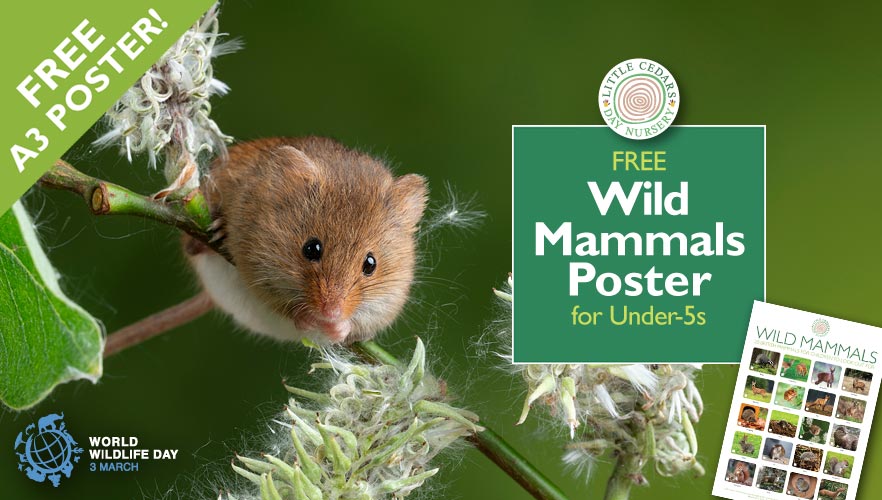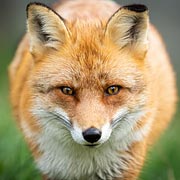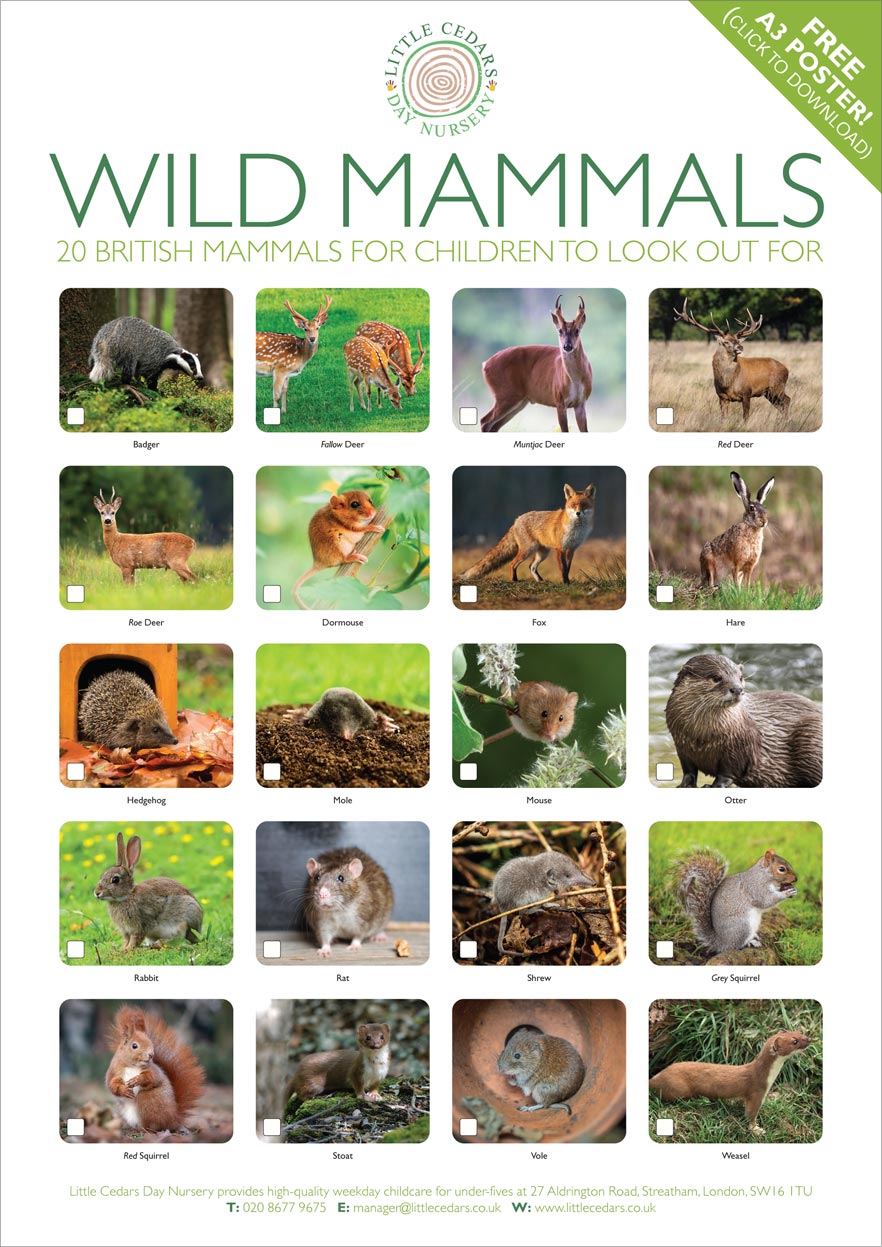
With World Wildlife Day falling on the 3rd of March and Spring virtually upon us, we thought it was a great time to produce another free wildlife poster for children and families to download. This one features 20 wild British* land mammals that children will love! Using the poster, they can learn to identify the animals shown and perhaps look out for them when out and about over the coming months and years. It’s a handy reference tool that can be used to get to know their furry neighbours, whether in local parks, on trips to the countryside, or whilst on holiday. While some creatures like grey squirrels are common to see, some of the others shown are more shy — but that just makes it more exciting when they are finally spotted!
 Getting children interested in nature, and spending time around it, is extremely good for them as we’ve reported before — the benefits of nature to children are simply huge. Today’s focus on British mammals will not only be a good way to encourage an interest in some of Britain’s wonderful creatures but may also help them understand more about the need to support conservation efforts and protect wildlife. It’s a great way to foster empathy in little ones too. We’ll tell you more about World Wildlife Day shortly but first, grab yourself and your children the free mammals poster — the creatures shown are stunningly beautiful and kids are bound to love displaying the poster.
Getting children interested in nature, and spending time around it, is extremely good for them as we’ve reported before — the benefits of nature to children are simply huge. Today’s focus on British mammals will not only be a good way to encourage an interest in some of Britain’s wonderful creatures but may also help them understand more about the need to support conservation efforts and protect wildlife. It’s a great way to foster empathy in little ones too. We’ll tell you more about World Wildlife Day shortly but first, grab yourself and your children the free mammals poster — the creatures shown are stunningly beautiful and kids are bound to love displaying the poster.
Download, print out and feel free to share this British Wild Mammals poster. Click the bold blue link or the preview image below and save to your hard drive. Once opened in Acrobat Reader and printed out, children can see if they can learn the different animal names and even spot some of the beautiful creatures over coming years while outside, in the countryside, or on holiday.
United Nations World Wildlife Day
World Wildlife Day celebrates the world’s flora and fauna. It happens on the 3rd of March each year and is a way to raise awareness of the need to protect nature. That can be achieved by reducing harmful emissions, pollution, habitat loss, and the loss of biodiversity. By introducing children to the beautiful wildlife around them, children will naturally be more empathetic towards other creatures and even progress to learning about conservation matters and the impact of humans on the planet. In this way, little ones can grow into young stewards of the planet and have an active interest in protecting it going forward. Get them started today by downloading our free Wild Mammals poster — who knows where it could lead!
Parents, teachers and early years practitioners can learn more about the United Nations World Wildlife Day here.
Other Free Wildlife Posters Children Can Download
Don’t forget that this is just one in a series of several wildlife/nature-related posters. All of them are free, shareable, and will be both fun and educational for children. Choose from today’s British Mammals poster above, our British Birds poster, Minibeasts poster, or Butterflies poster. Follow the links for more details and the free downloads.
Exceptional Childcare in Streatham
Little Cedars: a high-quality childcare nursery in Streatham, London, SW16

 We love nature and all the benefits it brings to children, so we’re lucky to be located close to Tooting Common at Little Cedars Day Nursery (Streatham, SW16). We also encourage children to get involved in planting and growing in our own garden at the setting as nature teaches them so much. It’s all part of the early years learning and development programme at the setting.
We love nature and all the benefits it brings to children, so we’re lucky to be located close to Tooting Common at Little Cedars Day Nursery (Streatham, SW16). We also encourage children to get involved in planting and growing in our own garden at the setting as nature teaches them so much. It’s all part of the early years learning and development programme at the setting.
Contact Little Cedars Nursery today and explore the possibility of a nursery/preschool place for your child in Streatham:
Based in Streatham, Little Cedars Nursery may also suit your little one if you are looking for a high-quality nursery or preschool near Tooting Common, Tooting, Streatham Hill, Streatham Park, Streatham Common, Furzedown, Tooting Bec, Tooting Broadway, Balham, Norbury or Colliers Wood.
| * By ‘British’ we mean mammals that can be found and seen in Britain. We are keeping things simple for little ones but appreciate, of course, that some of the animals featured were not originally indigenous to Britain. Examples include the Muntjac Deer (originally from China) and the grey squirrel (originally from North America). Even some red squirrels that we see in parts of Britain may be descendants of some that were imported to boost our own declining populations. We also appreciate that there are several sub-species not shown, e.g. several types of mouse, shrew, vole and others. That, again, is to keep things simple for little ones. |


